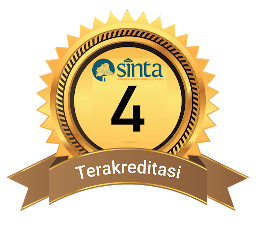Comparison of Chemistry Learning Results In Blended Learning Using Edmodo Media and Whatsapp Students of Class X IPA SMAN 7 Mataram
DOI:
10.29303/cep.v7i1.4554Published:
2024-05-31Issue:
Vol. 7 No. 1 (2024): Edisi Mei 2024Keywords:
Blended Learning, Edmodo, Whatsapp, SolutionArticles
Downloads
How to Cite
Abstract
This study aims to determine the differences in chemistry learning outcomes in blended learning using Edmodo media with Whatsapp class X students on electrolyte and nonelectrolyte solutions. This research is a Quasi Experimental Design research (quasi-experiment). The research design used in this study was a Quasi Experimental Design, namely the Non-Equivalent Control Group Design. Sample selection using purposive sampling technique. The research sample is experimental class I (X IPA 1) which applies blended learning using Edmodo media and experimental class II (X IPA 2) which applies blended learning using whatsapp media. The data collection technique used is a test instrument for understanding concepts (pretest and posttest) in the form of multiplechoice questions. Test the hypothesis in this study using the t-test. The results of the statistical test t-test tcount at a significant level of 5% shows tcount (2.43) > ttable (1,669) which means Ha is accepted and Ho is rejected. This shows that there is a significant difference in blended learning between using edmodo and whatsapp media in improving chemistry learning outcomes, where blended learning using Edmodo media is better in improving students' chemistry learning outcomes
References
Arota, A. S., Mursalin, & Odja, A. H. (2020). The effectiveness of e-learning based on SETS to improve students’ critical thinking skills in optical instrument material. Journal of Physics: Conference Series, 1521(2).
Alwan, M. (2017) Pengembangan Model Blended Learning Menggunakan Aplikasi Edmodo untuk Mata Pembelajaran Geografi SMA. Jurnal Inovasi Teknologi Pendidikan, 4(1), 65-85.
Astuti, Y & Setiawan, B. 2013. Pengembangan Lembar Kerja Siswa (LKS) Berbasis Pendekatan Inkuiri Terbimbing dalam Pembelajaran Kooperatif pada Materi Kalor. Jurnal pendidikan IPA Indonesia. 3(1).
Azmi, A. Wildan. Muntari & Yayuk, A (2021) Pengaruh Pembelajaran Daring dan Luring Terhadap Kemandirian Belajar Mahasiswa Program Studi Pendidikan Kimia Universitas Mataram Tahun (2021). Jurnal Chemistry Education Practice 5 (1). 66-70
Depdiknas. (2003). Undang-undang Nomor 20 tahun 2003, tentang sistem pendidikan nasional. Jakarta: Depdiknas.
Ekayati, R. (2018). Implementasi Metode Blended Learning Berbasis Aplikasi Edmodo. Jurnal Edu Tech, 4(2), 50-56.
Fadloli, M. E. & kusumo K. (2019). Pengembangan Model Pembelajaran Blended Learning Berbasis edmodo untuk pembelajaran kimia yang efektif. Jurnal Kimia FMIPA, 8(1), 1–6.
Fauziyah, S & Triyono.,M.,B (2020) Pengaruh E-Learning Edmodo Dengan Model Blended Learning Terhadap Minat Belajar. Jurnal Kependidikan 4(1). 112-124.
Kusuma, J. W. & Hamidah. (2020). perbandingan hasil belajar matematika dengan menggunakan platform whatsApp Group dan webinar zomm dalam pembelajaran jarak jauh pada masa pandemi covid-19. Jurnal Ilmiah Pendidikan Matemarika, 5(1), 97–105.
Muzyanah, S. H. Poewandar A. Yorinda B. (2018). Efektivitas Penggunaan Media Edmodo Sebagai PenunjangPembelajaran Kimia. Jurnal Pendidikan Kimia, 1(1), 33–45.
Ningsih, L. Y. & Misdalina. M. (2017). Peningkatan Hasil Belajar dan Kemandirian Belajar Metode Statistika Melalui Pembelajaran Blended Learning. Jurnal Pendidika Matematika, 8 (2), 155–164.
Sidiq, R. (2019). Pemanfaatan whatsApp Group dalam Pengimplementasian Nilai-Nilai Karakter Pancasila pada Era Disrupsi. Jurnal Pendidikan Sejarah, 4(2), 145–154.
Siregar, T., & Nensi, M. (2018). Model Pembelajaran Generatif Terhadap Hasil Belajar Kimia pada Materi Ikatan Kimia. Jurnal Ilmu Pendidikan Indonesia, 8(1), 1–10.
Wijoyo, H. (2020). Blended Learning Suatu Paduan. Bandung:CV Insan Cendekia Mandiri.
Yudha, R.,I (2018). Pengaruh teman sebaya dan minat belajar terhadap hasil belajar siswa kelas VII pada mata pelajaran IPS di SMA Negeri 6 Kota Jambi. ISTORIA: Jurnal Ilmiah Pendidikan Sejarah Universitas Batanghari, 2(1).108-113.
Author Biographies
Nur Hayati, Nur hayati
Muntari Muntari, Program Studi Pendidikan Kimia, Universitas Mataram. Mataram, Indonesia
Muti’ah Muti’ah, Program Studi Pendidikan Kimia, Universitas Mataram. Mataram, Indonesia
License
Copyright (c) 2024 Nur Hayati, Muntari Muntari, Muti’ah Muti’ah

This work is licensed under a Creative Commons Attribution-ShareAlike 4.0 International License.
Authors who publish with Chemistry Education Practice agree to the following terms:
- Authors retain copyright and grant the journal right of first publication with the work simultaneously licensed under a Creative Commons Attribution License 4.0 International License (CC-BY-SA License). This license allows authors to use all articles, data sets, graphics, and appendices in data mining applications, search engines, web sites, blogs, and other platforms by providing an appropriate reference. The journal allows the author(s) to hold the copyright without restrictions and will retain publishing rights without restrictions.
- Authors are able to enter into separate, additional contractual arrangements for the non-exclusive distribution of the journal's published version of the work (e.g., post it to an institutional repository or publish it in a book), with an acknowledgement of its initial publication in Chemistry Education Practice.
- Authors are permitted and encouraged to post their work online (e.g., in institutional repositories or on their website) prior to and during the submission process, as it can lead to productive exchanges, as well as earlier and greater citation of published work (See The Effect of Open Access).






